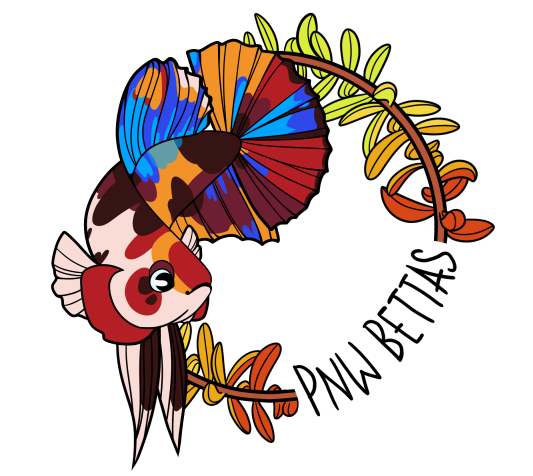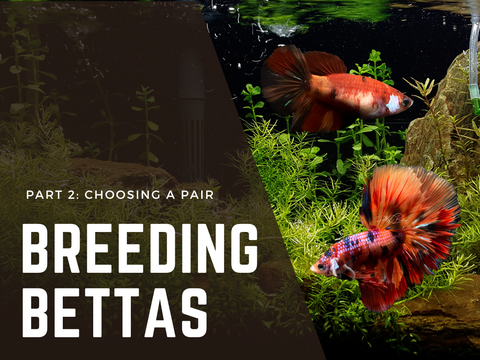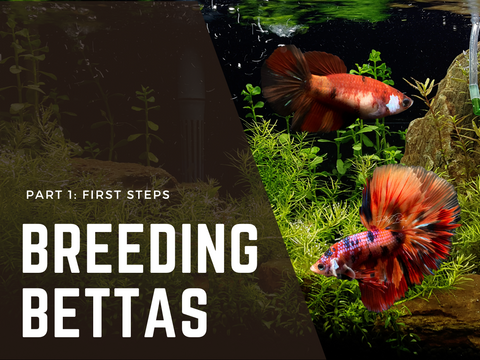Welcome to our next deep dive into breeding bettas! This is going to cover how to select a pair of bettas to breed. If you haven’t already, make sure to read the first part of this series: First Steps and Considerations.
So let’s get started: How do you choose a pair to breed when you want to responsibly breed healthy and high quality fish? I’m sure it comes to no surprise that it’s a bit more complex than just picking some pretty fish. So let’s walk through some things to think about when choosing fish, and some of my own recommendations.
I am so sorry this took so long to publish. This was honestly very challenging to create, as there is so much that goes into selecting fish for breeding. It was hard to put all that was in my head into words. So without further delay, lets dive into it!
Betta Tail Types Intro
The first step is deciding what tail type you want to work with. Bettas have come incredibly far in the last 5-10 years when it comes to tail types and colors, and there is so much variety to choose from.
Here are some common tail types:
Halfmoon: categorized by their D shaped tail that should have a 180° spread, along with a long tail.
Male:


Female:


Halfmoon Plakat (HMPK): similar to halfmoon, categorized by their D shaped tail that should have a 180° spread, but the tail is short in both males and females
Male:

Female:


Veiltail: asymmetrical appearance with a long caudal fin, narrow dorsal and an anal in the form of a trapezoid.
Male:

Female:

Crowntail: having fin rays that extend significantly beyond the webbed portion of the fins.
Male:


Female:

Double Tail Halfmoon: categorized by the split in their tail, similar to halfmoons in the tail size and shape.
Male:

Female:


Special note: Dumbos are commonly lumped in as a tail type, but a dumbo betta actually has nothing to do with their tail. The large pectoral fins can theoretically accompany any tail type. Currently there are mostly dumbo halfmoons, halfmoon plakats, and deltas.
Choosing a Tail Type
Theoretically you can choose any tail type to work with, but if you are a first time breeder we recommend you stick to a few types. Any type of plakat is our general recommendation, with preference towards HMPK due to them being easier to find and evaluate for quality form. The reason we suggest plakats over any other tail type is ease of spawning. Bettas are highly aggressive fish, and will almost always sustain some type of fin damage during spawning. With long finned fish, their delicate flowy finnage is easily torn, and can take months to fully grow back if severely damaged. It can also be really disappointing to see your prized breeding male severely torn up. A plakat betta may still sustain some torn finnage during spawning, but I have noticed it is generally less severe and due to the length it can grow back much quicker. We will discuss how to help bettas recover after spawning in a later post.
If you are set on breeding longer finned bettas, we still suggest you steer clear of doubletail bettas. Doubletail bettas, especially when crossed with another double tail, have high rates of spinal deformities. For this reason we recommend new breeders stay away from any type of doubletail completely. Instead we would recommend you stick to a nice halfmoon, crowntail, or veitail pair.
Betta Coloration
Next you have to pick a coloration! This is arguably the most fun part, as its what often draws people to bettas in the first place, their bright colorful patterns. Lets go over some common colorations and what they are called.
Solid Colors - A betta that is one solid color. Also sometimes called "super ____" such as "super yellow"

Bi-Colors - A betta that consists of two colors. Can be in color types such as "butterfly" or "grizzle"

Marbles - A betta with more then 2 different colors.
Marble bettas (often known as "koi" bettas) are by far the most popular coloration. Everything that you see labeled "koi", "galaxy", "nemo", "candy", "rainbow", "avatar", etc. are all just different marble patterns. These names should generally refer to common patterns of marbling. Refer to the examples and descriptions below to understand the basics!
Koi: A marble betta with red, blue, and black over a cellophane base

Nemo: Marble betta with red/yellow/orange

Galaxy: A marble betta with white/irradecent scales that are spread out to create "galaxy spots"

Avatar: A galaxy coloration with a high amount of galaxy spots. Normally in the blue/black coloration but can be other colorations as well.

Armogeddon/Dalmation:

Some bettas may be two "types" at once, such as a "nemo galaxy". Naming betta colorations can also get very subjective, so any color variations that do not fit the common types can be referred to as "marbles" for simplicity.
More information on colors can also be found starting on page 77 of the IBC Standards Book 1
Choosing a Coloration
With picking a color, you really can choose anything. To get the best results, generally you want to choose two fish with similar colorations or types. You can cross fish with different colorations, but the first generation will often not have the most desirable colors. We don't recommend doing this for first time breeders.
I find marbled bettas the most fun to breed because they produce the widest variety of offspring. They are also generally easier to sell/rehome as they appeal to the masses.
Coloration and Health
It's also important to touch on health and coloration. There are some colorations that are more prone to tumors or other issues. It's been said that marbles are more prone to tumors because of how their coloration works biologically (transposable elements, AKA "the jumping gene). But I have not personally experienced this in practice. That doesn't mean its not true, I just haven seen this correlation myself.
There are two specific colors I like to avoid: blue marbles and anything with dragon scaling or a large amount of solid white. This would also include blue rims and copper rims, and yellow/red/black dragons.
Blue marbles often become all blue as they become mature, which can be disappointing for the breeder and customer. But more importantly, they are more prone to tumors growths, specifically external growths. This is the same with dragon scale colorations. Along with tumors, these colorations are also more prone to diamond eye, where pigments grow over the bettas eyes, limiting their vision. While I have offered these colors in my shop due to popularity, and I know some people are still willing to take the risks with them, I do not really suggest workings with them as a breeding project.
So how do you now choose a specific pair?
So you have chosen the tail type and color you want to work with, now what? You need to select the actual fish you will be breeding!
This next topic is going to be the thing that sets apart casual breeding form breeders who are taking into consideration the quality of their fish. And that is going to be understanding proper betta body and fin shape, and choosing a pair that meets these standards.
The International Betta Congress has a written book of standards where all of the ideal body proportions, fin proportion, and body and fin shapes are outlined in detail. They have detail on many fin types, and also includes many diagrams.
Now this is for the purpose of showing bettas, and understanding what traits are desirable for a betta being shown compared to what would be considered faults. But these standards are NOT just for people who want to show their fish. Its an excellent guideline for understanding ideal betta proportions, and evaluating the fish you will be spawning.
These standards also take into consideration the health implications of certain traits. For example these standards specify that a no bettas should have swimming difficulty due to excess finnage or swim bladder disorder. These are listed under disqualifying faults for all betta types, and as a good rule of thumb, no bettas that you breed should display any of these faults either. Of course some of these are specific to showing and can be ignored for evaluating breeding fish, but many of these can be applied to a breeding pair as well.
The reason I recommend breeding to show standards is pretty simple, it creates more well balanced, nice looking fish with fewer health issues.
Show Plakat Standards
For the sake of my readers, and the length of this article, we will cover one tail type in detail. I will run you through the standards for male and female "show" halfmoon plakats, and what you are looking for in the ideal breeding pair.
Males:
The following information is copped directly from the IBC Standards, so you can also follow the page numbers to get the same information.
(Show plakat males start on page 67. General body standards start on page 45.)
Dorsal: The dorsal fin should be semicircular and preferably snap open as a fan. In the most ideal situation the dorsal overlaps the upper part of the caudal. The upper front edge can be either sharp or slightly rounded. The capacity of the fin to open in this fashion is often achieved not by in increase in volume, but by an increase in fin ray branching and possibly a slight increase of rays. In the most ideal situation, the dorsal overlaps the upper part of the caudal. Overlap of the dorsal with the body is not desirable.
Caudal (tail): Unlike the traditional plakat, the caudal fin is the same as the standard show betta. The caudal spread is 180 degrees, has straight rays, sharp edges and the shape of a semi-circle (capital “D”), no longer the 1/3rd the length of the body. The ray splitting should be evenly distributed with a secondary branching (4-ray) or more without becoming too excessive. A >180 degree spread (over halfmoon, oHM) is not preferred above a 180 degree spread.

Anal: The anal fin has a trapezoid shape with the front rays (anterior) part shorter than the rear (posterior) part. From the front to the back the anal show as gradual slope coming to a pointed tip. The longest ray of the anal ideally should be at least twice as long or longer (preferred) as the length of the outer rays of the caudal. During flaring, the front should be directed forward and the back should overlap the lower part of the caudal.
Ventrals: The shaper of the ventrals mimic the blade of a knife with the cutting edge directed backwards. The ventrals have a full appearance, are equal in length and should not appear to be permanently crossed. The length of the ventrals should be at least equal to the longest ray of the anal.
Plakats can also be bred to traditional form, which has some slight differences from the show form. Here is a diagram outlining the major differences.

Females
(starts on page 69)
Female traditional and show plakat bettas are of the same general form as their male counterparts, but with shorter fins and broader bodies.
The IBC encourages in this class the distinctive female plakat form. Female Plakat bettas vary considerably from males in several ways and should always appear "female."
Females are generally expected to be somewhat smaller overall. They are usually more rounded in the belly area than males. Female fins are not expected to reach the same size or proportion of the male finnage.
GENERAL CHARACTERISTICS
1. The female plakat is not expected to have the finnage of their long-fin female counterparts. The dorsal is expected to be smaller.
2. The dorsal of a female plakat may open like a fan as in the male form.
3. The anal fin will be shorter; with slight rounding at the front of the anal fin and will show an extended point at the tip of the fin.
4. Females are expected to show an egg spot.
5. Females should be more aggressive in their deportment than their long fin female counterparts.
The show female plakats will have the same characteristics of the traditional female (the dorsal fin will be smaller. The anal fin has a trapezoid shape with the forward (anterior) edge shorter than the rear (posterior) edge) except that the caudal spread is 180 degrees, has straight rays, sharp edges and the shape of a semi-circle (capital “D”).
Utilizing this information:
There are a few ways in which you can utilize this information. It can be a lot to understand, especially all at once. But you don't have to memorize these standards and find the perfect fish. What I think is a more important take away is the fact that we are critically evaluating WHY we are choosing a fish to breed. We are looking at their body shape, fin shape, coloration, and then connecting these back to our goals (which we talked about in the first article!).
Where to buy your breeding pairs:
Of course, we want to recommend our own online shop, but I actually believe that being able to see your fish in person is the best way to select breeding pairs. Now this only is useful if you actually have a local store that stocks higher quality bettas, and displays them properly. Many stores only have pet betta fish (cheaper fish from large farms, bred to be pets only with no consideration into form/quality), or house them in ways that inhibit natural behaviors and are detrimental to their health. I firmly believe that buying bettas out of a cold unheated cup in a pet store is not a great way to get started with breeding specifically. If you do have a store that houses bettas in heated setups with clean water, and sources nicer bettas from better farms, then they are perfect to shop from!
This is what we do at our retail location in Corvallis OR. I (the owner) work almost every day here and would be more then happy to help you select a breeding pair in person.
The reason I recommend being able to see the fish first, is you can observe their behavior. In both males and females I look for them to be active, and be pretty agressive when flaring. For males specifically I look for indivisuals who arent too "zoomy" when flaring, and focus more on posturing and "wagging" their bodies as opposed to rapidly swimming back and forth. For females I just want to see them flare at males and be agressive as well.
Now not everyone is going to have a local store that stocks what you are looking for, so if thats the case you can absolutly order online. We dont post videos of our fish for each listing, but we can do videos upon request for a few fish (pre-selelct a few fish email us for the request, please don't ask for videos of ALL fish).
You can also get tons of information from good quality photos. Ideally the fish will be at a full flare and you can evaluate the body form and finnage. This is actually why I try and photogrph each fish flaring, so these can be evaluated. Its also MUCH easier to do this from a photo rather than a video.
For our online store, if you would like help selecting a breeding pair, please email us with what you are looking for and we can get you started!
How many pairs?
The last topic we need to cover is how many pairs of bettas you should start with. This will vary person to person drastically. You can start with just 1 pair (2 fish), or you can do multiple. Keep in mind that your breeding pairs can not live in the same aquarium, and you will need permimant aquariums for each fish you get. Trying multiple pairs at once may increase the odds of getting fry your first time around, but only spawn multiple pairs if you could raise both of them sucsessfully. You can also try spawing the same pair multiple times if they arent sucsessful the first time around.
When I did my first breeding project, I only started with one pair. But it took me 2-3 attempts before I got the fish to spawn.
Ultimaylu you will have to evaluate your long term breeding goals, and figutre out whays going to work best for you.
Conclusion
We are now reaching the end of our article, on selecing your breeding pairs. As always, if you have any questions, please leave a comment or email us. Our next topic will cover how to prepare to spawn your bettas, and how to properly condition them for breeding, so stay tuned!




Comments (0)
There are no comments for this article. Be the first one to leave a message!